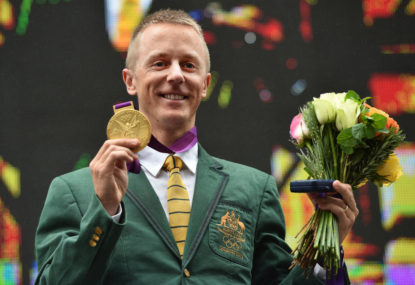'An iconic roster': LeBron, Steph, KD headline all-star cast for Team USA's shot at Olympic glory
LeBron James is going back to the Olympics for the first time in 12 years. Steph Curry is headed to the games for the…

In watching Australian athletes at the 2016 Rio Games, I urge viewers to take time to reflect on where they are at in their Olympics/Paralympics journey – gaining experience or strong contender for a medal. This a case study of recently-crowned Olympic gold medallist Jared Tallent.
I was privileged to work at the Australian Institute of Sport (AIS) for over 30 years and I have been able to observe many Olympic and Paralympic athletes’ journeys. Tallent’s journey highlights many of the factors that contribute to developing an Olympic/Paralympic Games medallist or finalist today. These factors include high-performance training centres, role models, international competition, expert coaching and sports science and medicine.
Tallent’s life starts growing up in a family of six children on a potato farm near Ballarat. He took up little athletics and was coached by local athletics coach Daryl Biggin until he moved to the AIS after secondary school.
Many of Australia’s elite athletes have been nurtured in the country and Tallent is also an example of the long line of track and field athletes developed through little athletics. Sally Pearson is a notable recent example.
Besides athletics, Tallent was a successful junior triathlete and finished second at the Victorian School Championships. Undertaking several sports in their younger years often appears to help athletes in their development.
His successful junior athletics career led to him being offered a scholarship to the AIS at the end of 2003 and he moved there at the time when highly credentialled walkers Nathan Deakes and Luke Adams were training for the 2004 Athens Olympics. Deakes went on to win the bronze medal in the 20 km walk at Athens Olympics.
In reflecting on the international success of the AIS walks program since 1981, three factors seem to be very important in the developing champion athletes like Tallent.
Firstly, there were many excellent role models for up-and-coming walkers at the AIS. These role models included major event medallists and word record holders – Sue Cook, Kerry Saxby-Junna, Dave Smith, Simon Baker, Nick A’Hern, Jane Saville, Luke Adams and Nathan Deakes.
While at the AIS, I witnessed how Russian Olympic swimming champion Alexander Popov was an excellent role model for the likes of future Olympic medallists Michael Klim, Todd Pearson, Bill Kirby, Justin Norris, Sarah Ryan and Petria Thomas during the 1990s.
Secondly, expert coaches are very important in developing athletes and the AIS has employed and developed highly successful walks coaches – Craig Hilliard, Simon Baker, German Ron Weigel and Brent Vallance.
Thirdly, Olympic/Paralympic athletes need access to international competition. One of the main tenants of the AIS, when it was established, was to ensure Australian athletes had exposure to more international competitions.
Tallent’s first major international multi-sport competition was the 2006 Melbourne Commonwealth Games where he won the bronze medal behind Deakes and Adams in the 20 km walk.
Numerous other Australian athletes have used the Commonwealth Games as a stepping stone. Cathy Freeman famously won a gold medal as a 16-year-old at the 1990 Auckland Commonwealth Games in the 4×100 metres relay. We all know where this starting point led to – silver at the Atlanta Olympics and gold at the Sydney Olympics.
So when Tallent lined up at the 2008 Beijing Olympics, he had been to two World Championships and a Commonwealth Games. This would have definitely prepared him for Beijing Olympics which led to a silver and a bronze medal. This highlights the importance of introducing talented young athletes to international competition at an early stage.
Many talent identification researchers have argued that it takes 10,000 hours or 10 years to become an expert in sport. As a 17-year-old, Tallent finished seventh in the 10 km walk at the 2001 World Youth Championships. Wind the clock forward 11 years, he won the gold medal at the 2012 London Olympics in the 50 kilometres walk. This timeframe appears to match talent identification expertise research.
Sadly for Tallent, walks events have been impacted by doping, particularly by Russian and Italian athletes. It must be difficult for an athlete to compete in these circumstances. Tallent while at the AIS has been a strong supporter of its ethical and legal sports science and medicine services and research.
Tallent has incorporated AIS extensive research into altitude training into his year-round training and has worked with AIS nutrition to utilise optimal training and competition diets. In December 2015, Tallent co-opted 20 race walkers from around the world to come to the AIS to be part of a four-week study into high-carb, high-fat and periodised diet.
Tallent emphasised the importance of nutrition in his London Olympics Campaign by stating “I worked with Louise (Burke) before London about getting in the maximum amount of carbs in before a race and then what fuel I was using during races. We came up with a strategy and practised that and it was by far the best 50km race I’ve ever had.”
Tallent’s journey is mirrored by many other Olympic/Paralympic athletes. Some or all of the factors mentioned give athletes the optimum chance of standing on the dias.